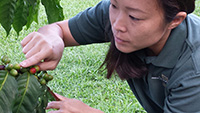Andrea Kawabata vs the Coffee Berry Borer
 An African beetle barely a 16th of an inch long threatens Hawai‘i's $34 million signature coffee crop. Female coffee berry borers drill into the coffee cherry, laying 2–3 eggs a day for 20 days. They and their larva damage the coffee bean as they feed. Female offspring bide their time between seasons, emerging after a rain, already pregnant and in search of a new home.
An African beetle barely a 16th of an inch long threatens Hawai‘i's $34 million signature coffee crop. Female coffee berry borers drill into the coffee cherry, laying 2–3 eggs a day for 20 days. They and their larva damage the coffee bean as they feed. Female offspring bide their time between seasons, emerging after a rain, already pregnant and in search of a new home.
“This beetle isn’t going anywhere,” says Andrea Kawabata, CTAHR assistant extension agent and farmers’ champion in the berry borer battle. “If growers don’t manage the coffee berry borer, it can wipe out nearly 100 percent of the crop.” She is helping farmers mount a defense using strategies developed by CTAHR scientists and endorsed by USDA, the state Coffee Berry Borer Task Force, and industry groups. She helped organize a coffee berry borer summit in 2013 and has been island hopping to help explain the Integrated Pest Management strategies to coffee growers from Ka‘u to O‘ahu.
Kawabata has strong island roots. Her uncle was a Big Island orchid grower. While studying agriculture at UH Hilo, she was a student employee at CTAHR’s Beaumont Research Station. As a master’s student at Manoa, she focused her research on rambutan trees. She went to work at CTAHR's Kona Extension Office not long after the coffee berry borer’s presence was confirmed in South Kona in late 2010.
—From CTAHR in Focus, January 2014
UPDATE: In early 2014, Kawabata accompanied CTAHR scientist Scot Nelson on farm visits to investigate a new coffee threat: an emaravirus that came to Nelson's attention through an app he created called Plant Doctor.
Read the news release about their detective work or watch the KITV news report.